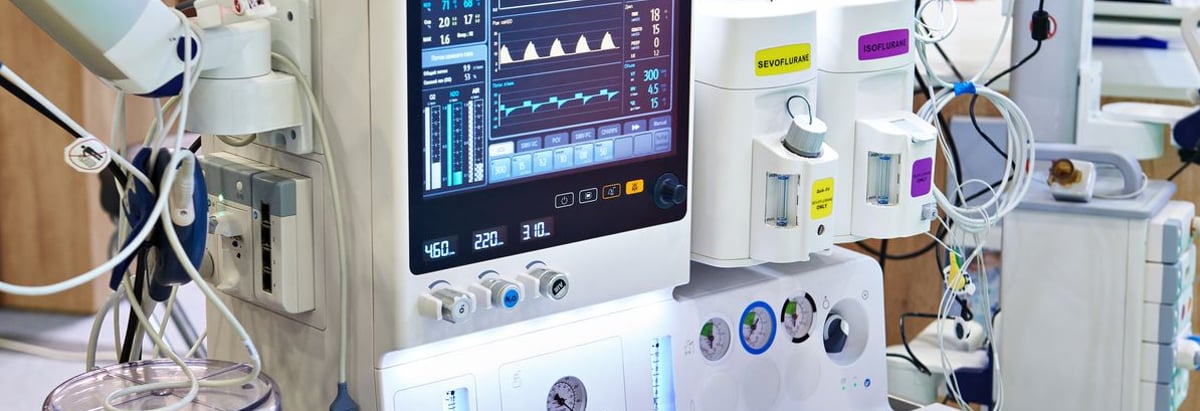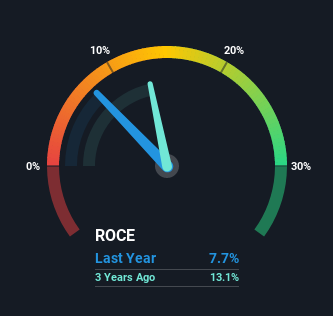- United Kingdom
- /
- Medical Equipment
- /
- LSE:SN.
Smith & Nephew (LON:SN.) Might Be Having Difficulty Using Its Capital Effectively

Did you know there are some financial metrics that can provide clues of a potential multi-bagger? In a perfect world, we'd like to see a company investing more capital into its business and ideally the returns earned from that capital are also increasing. Ultimately, this demonstrates that it's a business that is reinvesting profits at increasing rates of return. However, after briefly looking over the numbers, we don't think Smith & Nephew (LON:SN.) has the makings of a multi-bagger going forward, but let's have a look at why that may be.
Understanding Return On Capital Employed (ROCE)
For those that aren't sure what ROCE is, it measures the amount of pre-tax profits a company can generate from the capital employed in its business. To calculate this metric for Smith & Nephew, this is the formula:
Return on Capital Employed = Earnings Before Interest and Tax (EBIT) ÷ (Total Assets - Current Liabilities)
0.077 = US$677m ÷ (US$11b - US$2.1b) (Based on the trailing twelve months to July 2021).
Therefore, Smith & Nephew has an ROCE of 7.7%. Ultimately, that's a low return and it under-performs the Medical Equipment industry average of 11%.
See our latest analysis for Smith & Nephew

In the above chart we have measured Smith & Nephew's prior ROCE against its prior performance, but the future is arguably more important. If you're interested, you can view the analysts predictions in our free report on analyst forecasts for the company.
So How Is Smith & Nephew's ROCE Trending?
When we looked at the ROCE trend at Smith & Nephew, we didn't gain much confidence. Around five years ago the returns on capital were 14%, but since then they've fallen to 7.7%. Meanwhile, the business is utilizing more capital but this hasn't moved the needle much in terms of sales in the past 12 months, so this could reflect longer term investments. It's worth keeping an eye on the company's earnings from here on to see if these investments do end up contributing to the bottom line.
Our Take On Smith & Nephew's ROCE
To conclude, we've found that Smith & Nephew is reinvesting in the business, but returns have been falling. Unsurprisingly, the stock has only gained 18% over the last five years, which potentially indicates that investors are accounting for this going forward. So if you're looking for a multi-bagger, the underlying trends indicate you may have better chances elsewhere.
On a final note, we've found 2 warning signs for Smith & Nephew that we think you should be aware of.
If you want to search for solid companies with great earnings, check out this free list of companies with good balance sheets and impressive returns on equity.
New: Manage All Your Stock Portfolios in One Place
We've created the ultimate portfolio companion for stock investors, and it's free.
• Connect an unlimited number of Portfolios and see your total in one currency
• Be alerted to new Warning Signs or Risks via email or mobile
• Track the Fair Value of your stocks
This article by Simply Wall St is general in nature. We provide commentary based on historical data and analyst forecasts only using an unbiased methodology and our articles are not intended to be financial advice. It does not constitute a recommendation to buy or sell any stock, and does not take account of your objectives, or your financial situation. We aim to bring you long-term focused analysis driven by fundamental data. Note that our analysis may not factor in the latest price-sensitive company announcements or qualitative material. Simply Wall St has no position in any stocks mentioned.
Have feedback on this article? Concerned about the content? Get in touch with us directly. Alternatively, email editorial-team (at) simplywallst.com.
About LSE:SN.
Smith & Nephew
Develops, manufactures, markets, and sells medical devices and services in the United Kingdom, the United States, and internationally.
Established dividend payer and good value.
Similar Companies
Market Insights
Community Narratives



